Two years ago I learned that I was eligible for a service dog, and in fact, that my already highly trained dog who had been unofficially helping me for much of her life knew a sufficient number of "tasks" to be immediately designated a legal Service Dog in Training. In Oregon, service dogs in training who know "tasks" are allowed full public access rights so long as they meet certain "politeness" and cleanliness requirements, and since she did, the following week she was able to start accompanying me everywhere in public and start tasking for me at all times, not just at home.
My quality of life SHOT UP immediately; I felt so much more empowered to go places, with much less fear something would happen to me while I was out that would strand me there because I was shaking too much to drive or other similar miseries.
However, I also began to encounter frequent misunderstandings from the public, who would sometimes become quite hostile in their attempts to claim that "I wasn't disabled enough" to need a service dog, or that she could not be a real service dog because she was "too pretty" or "Poodles aren't real service dogs"
It got so common and disruptive that I designed a pamphlet and had several hundred printed, and started automatically handing them to anyone who I saw giving us side-eye (or to children who were delighted by her but disappointed or confused that they weren't allowed to pet her.) The pamphlets helped A LOT and we were much less frequently followed around by shouting men in stores.
Ignore all the years of tea staining on my desk
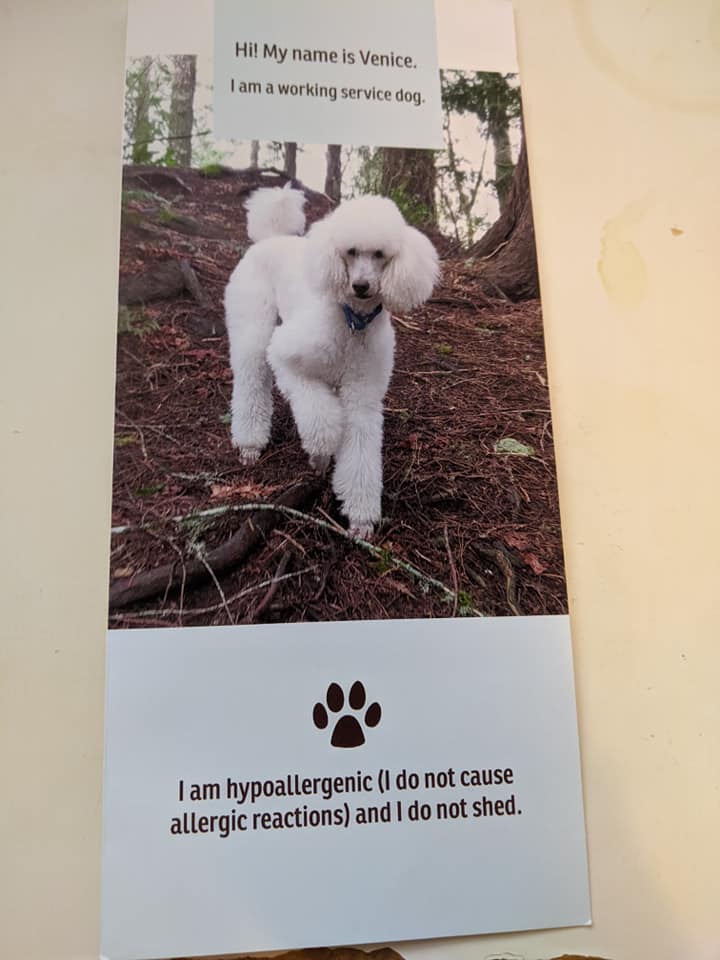
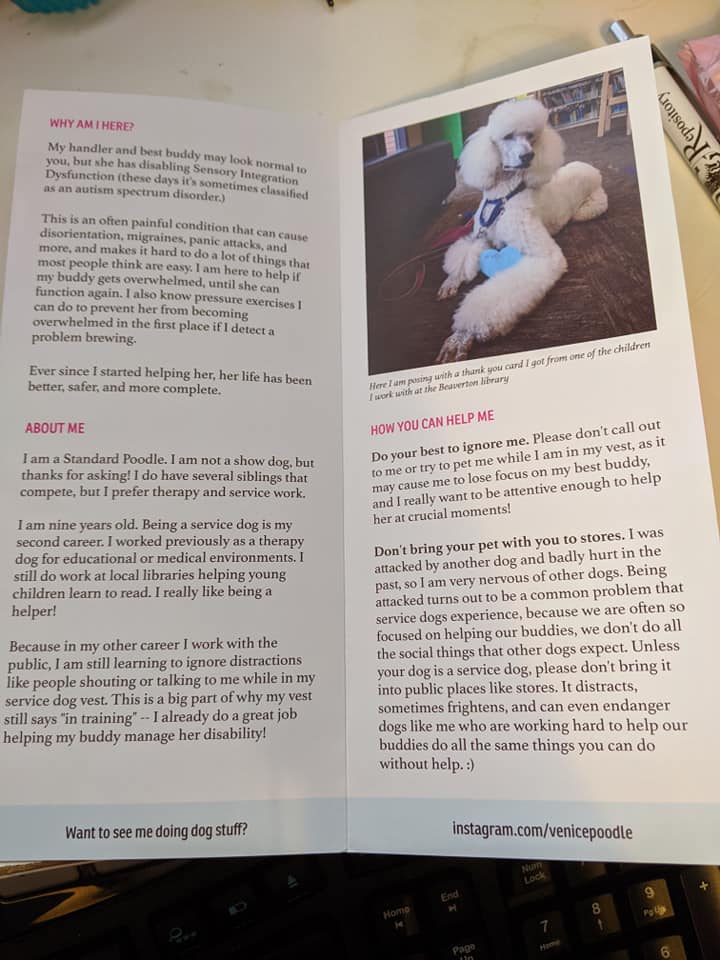
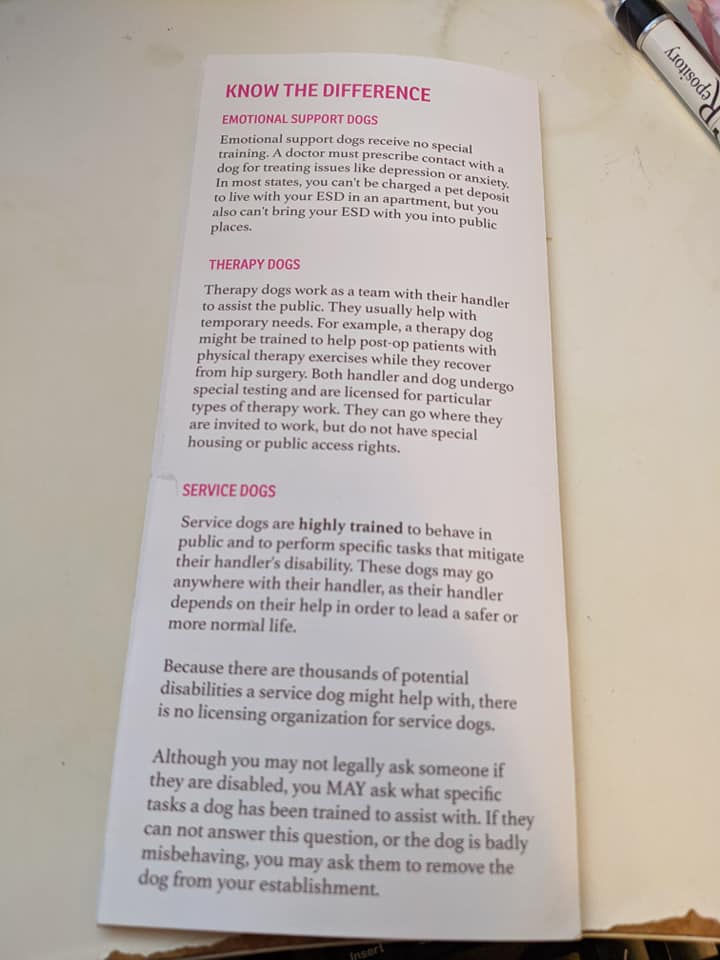
Obviously the pandemic means we don't go into public really at all anymore, but my brief experiences with the public's reactions to service dogs made me passionate about educating people as best as I was able. So... ask me anything. I'm not an expert, but I'll give you my best understanding. based on our experiences
Edit: Forgot to mention, I'll also answer questions about my disability as well if anyone wants to know.
My quality of life SHOT UP immediately; I felt so much more empowered to go places, with much less fear something would happen to me while I was out that would strand me there because I was shaking too much to drive or other similar miseries.
However, I also began to encounter frequent misunderstandings from the public, who would sometimes become quite hostile in their attempts to claim that "I wasn't disabled enough" to need a service dog, or that she could not be a real service dog because she was "too pretty" or "Poodles aren't real service dogs"
It got so common and disruptive that I designed a pamphlet and had several hundred printed, and started automatically handing them to anyone who I saw giving us side-eye (or to children who were delighted by her but disappointed or confused that they weren't allowed to pet her.) The pamphlets helped A LOT and we were much less frequently followed around by shouting men in stores.
Ignore all the years of tea staining on my desk



Obviously the pandemic means we don't go into public really at all anymore, but my brief experiences with the public's reactions to service dogs made me passionate about educating people as best as I was able. So... ask me anything. I'm not an expert, but I'll give you my best understanding. based on our experiences
Edit: Forgot to mention, I'll also answer questions about my disability as well if anyone wants to know.
How long have you had Venice before you found out about her being eligible to be a service animal and also may I ask what the disability is? Also that pamphlets idea is a smart move
I had Venice for 8 years before I learned that she could officially be a service dog. Luckily, in that time she had trained to become a licensed therapy dog, which gave her a head start on some of the public access skills she would need as a service dog. She had also proved herself EXTREMELY intelligent and in love with working, so I knew right away that she could master the necessary skills to become my service dog.
My official diagnosis as a child was "Sensory Integration Dysfunction," but this is a condition that is thought now to really just be one presentation of autism spectrum. It was not recognized as autism back in the day, and instead misdiagnosed in people who are good at "masking," ie, mimicking the expected social behaviors of non-autistics and forcing themselves to not visibly react when exposed to their triggers.
For me, it is most obvious in sound triggers and some visual triggers. For example, when I hear someone whistling, it causes me a sensation that I can most closely describe as extreme pain. That pain can rapidly develop into shaking, sweating, dry heaving or even vomiting, freezing, full panic attacks or fight or flight reactions. Imagine you have a number of triggers like that, sounds people make without thinking about, so every time you leave your house you run the risk of being assaulted by strangers, perhaps multiple times. The stress can leave me exhausted for days, and sometimes I get extremely ill for long periods of time when I have to force myself to endure being around my triggers for hours or days (attending school was a red haze of pain for me and I was sick CONSTANTLY. I've gotten MUCH healthier since graduating and starting to work from home.)
Venice has been taught a number of "tasks" to help mitigate these issues for me. If, say, someone in a grocery store one aisle over suddenly starts whistling on the other side of a shelf and I freeze up, she can help guide me away and stands in a "Blocking" position so other people won't try to approach or touch me while I'm recovering. There are also certain pressure exercises that can help to shorten one of these episodes and calm me down that can only be performed with a partner, and she has known since she was VERY young how to be that partner for me and do pressure exercises on me when I am exhibiting distress.
My official diagnosis as a child was "Sensory Integration Dysfunction," but this is a condition that is thought now to really just be one presentation of autism spectrum. It was not recognized as autism back in the day, and instead misdiagnosed in people who are good at "masking," ie, mimicking the expected social behaviors of non-autistics and forcing themselves to not visibly react when exposed to their triggers.
For me, it is most obvious in sound triggers and some visual triggers. For example, when I hear someone whistling, it causes me a sensation that I can most closely describe as extreme pain. That pain can rapidly develop into shaking, sweating, dry heaving or even vomiting, freezing, full panic attacks or fight or flight reactions. Imagine you have a number of triggers like that, sounds people make without thinking about, so every time you leave your house you run the risk of being assaulted by strangers, perhaps multiple times. The stress can leave me exhausted for days, and sometimes I get extremely ill for long periods of time when I have to force myself to endure being around my triggers for hours or days (attending school was a red haze of pain for me and I was sick CONSTANTLY. I've gotten MUCH healthier since graduating and starting to work from home.)
Venice has been taught a number of "tasks" to help mitigate these issues for me. If, say, someone in a grocery store one aisle over suddenly starts whistling on the other side of a shelf and I freeze up, she can help guide me away and stands in a "Blocking" position so other people won't try to approach or touch me while I'm recovering. There are also certain pressure exercises that can help to shorten one of these episodes and calm me down that can only be performed with a partner, and she has known since she was VERY young how to be that partner for me and do pressure exercises on me when I am exhibiting distress.
Did you train Venice or was it done by somebody else? What was the process like?
I trained her.
I think our path to service dog work was a little abnormal; many service dogs begin intensive training as puppies in the specific field they'll be working in.
Venice started by being trained as a therapy dog rather than as a service dog. People use these terms interchangeably, but they are very different. I'll explain more in a second.
I initially sought out the therapy dog training because she had made it so clear that she wanted valuable work to do, and much like a herding dog without something to herd, wasn't comfortable in her own skin without doggy knowledge work to perform. I don't know why I didn't think about going for service dog first... for a long time I sort of downplayed my own disability and tried to "tough it out" no matter what the cost was to myself, and felt like well, other people have it worse, so I shouldn't complain. So it took me a long time to realize that I needed help, deserved it, and indeed, had it at my fingertips.
So, back to the story of therapy dogging. For the initial therapy dog work, we attended classes. In therapy dog work, the dog works in a team with the handler (me) to take care of members of the public together. If the dog is unsure how to be helpful, the handler can prompt them.
Service dogs take care of their handler (me) even if the handler is incapacitated and unable to instruct the dog in what their needs are in the moment, which is much more advanced. The dog has to be able to make decisions on its own even with incomplete info, have fallback tactics, maybe even methods of asking strangers for help if necessary and the like.
BUT, there were a lot of useful skills and training techniques that we learned through all those different therapy dog courses that helped us make the leap to service dog work.
For example: Both service dogs and therapy dogs need to be *very chill* in public and not react negatively when startling or even frightening stuff is going down. Like if there is a very loud noise, like a car backfiring or an in patient at a mental facility having a melt down and screaming or smashing things. Both therapy and service dogs need to not startle, bite, howl, or exhibit any other negative behavior that might escalate the situation. In classes, she would practice sitting in front of me and holding eye contact with me as the instructor dropped increasingly large objects on the floor behind her. Eventually, we would practice in an echoing warehouse, and the instructor would climb up on a ladder and drop pots and pans on the concrete floor. She learned to be rock-steady no matter what was going on. Sometimes actors would come to class and simulate getting into a vocal or physical fight so the therapy dogs in training could practice not getting upset over it. You start small and work up. I am personally a big proponent of clicker training, where you mark the exact moment the behavior you want occurs with a click and then offer a treat after.
Service dogs need to not make nuisances of themselves in restaurants by getting underfoot of servers or begging for table scraps or any other such thing. They learn to fold themselves under the table and go to sleep. We had a good head start in this because of therapy dog classes; we did a LOT of exercises practicing ignoring meals on trays, like at hospitals or in school cafeterias, which again, gave us a great head start there.
In many ways, the service dog public access politeness stuff was a natural advancement of what we had already practiced together for our therapy dog license.
The "tasks" she performs as a service dog I trained when she was a puppy, not fully realizing what I was doing or how useful it was going to be. I just knew I felt worlds better when she firmly pressed the top of her head to certain pressure points on my body, or climbed on top of me and mimicked a weighted blanket when I was badly overwhelmed. Later, I learned that these are common basic tasks that service dogs meant to help people with autism are taught. I told her when I was mildly distressed at home what I needed, and she happily obliged.
I'm not sure how I would have gone about training her to do those exercises to me in situations where I'm not functional enough to instruct her to start doing them. I lucked out that her several years working with children in distress and having me at first coach her through how to be helpful in ways appropriate to the situation, she transitioned that knowledge into working with me in situations where I was not being helpful without my really needing to do much. I flat out lucked out on that one that she was willing and able to generalize her knowledge from that first job into working her second job.
I think our path to service dog work was a little abnormal; many service dogs begin intensive training as puppies in the specific field they'll be working in.
Venice started by being trained as a therapy dog rather than as a service dog. People use these terms interchangeably, but they are very different. I'll explain more in a second.
I initially sought out the therapy dog training because she had made it so clear that she wanted valuable work to do, and much like a herding dog without something to herd, wasn't comfortable in her own skin without doggy knowledge work to perform. I don't know why I didn't think about going for service dog first... for a long time I sort of downplayed my own disability and tried to "tough it out" no matter what the cost was to myself, and felt like well, other people have it worse, so I shouldn't complain. So it took me a long time to realize that I needed help, deserved it, and indeed, had it at my fingertips.
So, back to the story of therapy dogging. For the initial therapy dog work, we attended classes. In therapy dog work, the dog works in a team with the handler (me) to take care of members of the public together. If the dog is unsure how to be helpful, the handler can prompt them.
Service dogs take care of their handler (me) even if the handler is incapacitated and unable to instruct the dog in what their needs are in the moment, which is much more advanced. The dog has to be able to make decisions on its own even with incomplete info, have fallback tactics, maybe even methods of asking strangers for help if necessary and the like.
BUT, there were a lot of useful skills and training techniques that we learned through all those different therapy dog courses that helped us make the leap to service dog work.
For example: Both service dogs and therapy dogs need to be *very chill* in public and not react negatively when startling or even frightening stuff is going down. Like if there is a very loud noise, like a car backfiring or an in patient at a mental facility having a melt down and screaming or smashing things. Both therapy and service dogs need to not startle, bite, howl, or exhibit any other negative behavior that might escalate the situation. In classes, she would practice sitting in front of me and holding eye contact with me as the instructor dropped increasingly large objects on the floor behind her. Eventually, we would practice in an echoing warehouse, and the instructor would climb up on a ladder and drop pots and pans on the concrete floor. She learned to be rock-steady no matter what was going on. Sometimes actors would come to class and simulate getting into a vocal or physical fight so the therapy dogs in training could practice not getting upset over it. You start small and work up. I am personally a big proponent of clicker training, where you mark the exact moment the behavior you want occurs with a click and then offer a treat after.
Service dogs need to not make nuisances of themselves in restaurants by getting underfoot of servers or begging for table scraps or any other such thing. They learn to fold themselves under the table and go to sleep. We had a good head start in this because of therapy dog classes; we did a LOT of exercises practicing ignoring meals on trays, like at hospitals or in school cafeterias, which again, gave us a great head start there.
In many ways, the service dog public access politeness stuff was a natural advancement of what we had already practiced together for our therapy dog license.
The "tasks" she performs as a service dog I trained when she was a puppy, not fully realizing what I was doing or how useful it was going to be. I just knew I felt worlds better when she firmly pressed the top of her head to certain pressure points on my body, or climbed on top of me and mimicked a weighted blanket when I was badly overwhelmed. Later, I learned that these are common basic tasks that service dogs meant to help people with autism are taught. I told her when I was mildly distressed at home what I needed, and she happily obliged.
I'm not sure how I would have gone about training her to do those exercises to me in situations where I'm not functional enough to instruct her to start doing them. I lucked out that her several years working with children in distress and having me at first coach her through how to be helpful in ways appropriate to the situation, she transitioned that knowledge into working with me in situations where I was not being helpful without my really needing to do much. I flat out lucked out on that one that she was willing and able to generalize her knowledge from that first job into working her second job.
I thought I would provide some examples of exercises we did to help Venice get good at ignoring distractions or doing stuff humans might deem impolite while on duty --
Here is outdoor temptation practice. I would change up the lures every time. In this one, you can see a bowl of a favored kibble, some favorite toys and favorite treats. Other times I would put out plates of hot dogs, or even put out my guinea pigs in little enclosures. She LOVES to harass the guinea pigs.
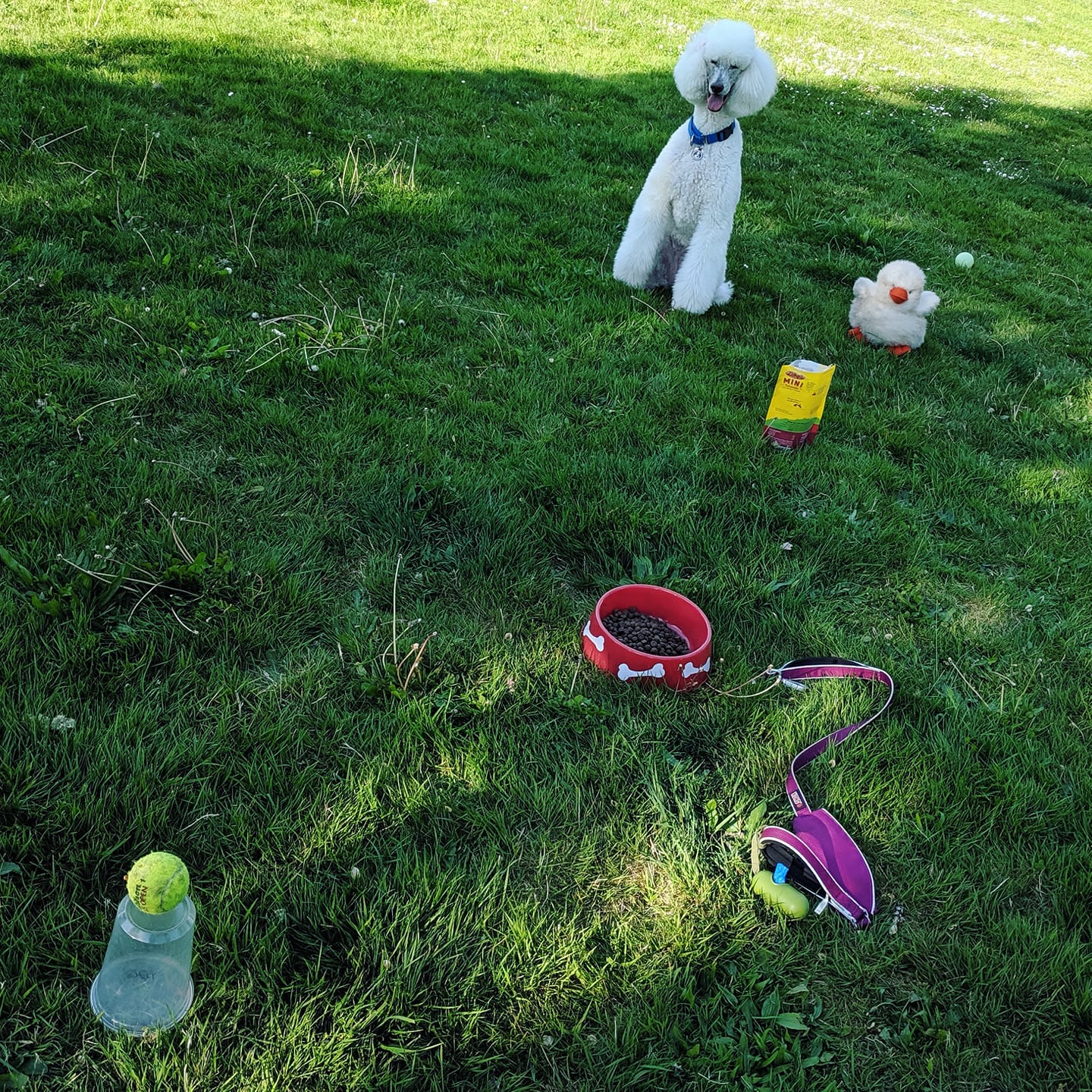
For temptation practice, we would walk past the lures and she would be asked to keep her eyes forward and her attention on me. We would start six feet away, then eventually we would walk past inches from the lures, and in final passes, I would have her weave in and out between the lures without being on a leash.
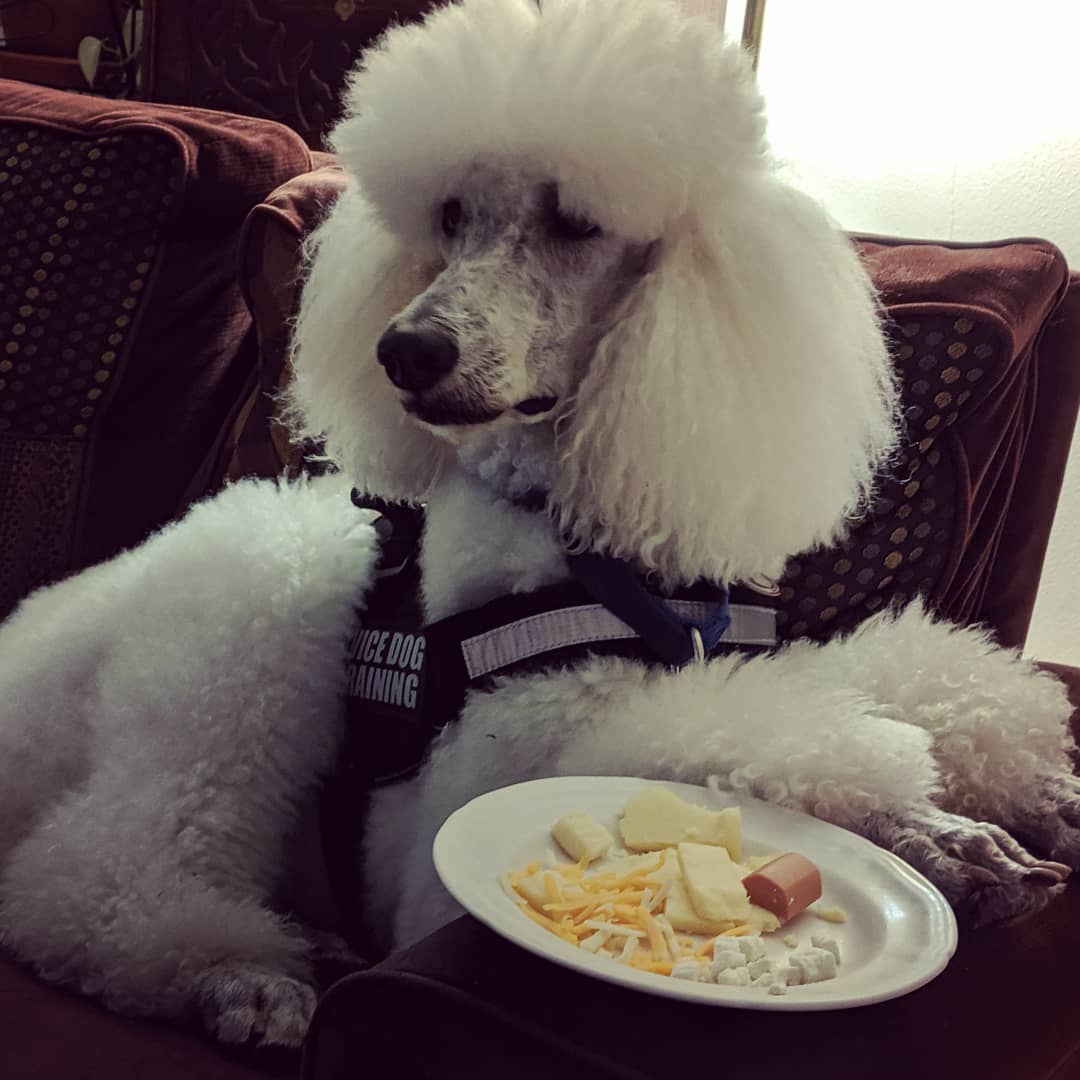
For indoor practice, she would sit next to a lure (pictured here, a plate of several different kinds of cheese) for increasingly long periods of time, eventually watch-a-movie length periods of time.
Once she had mastered these skills, I no longer had any fear that she would trip a server at a restaurant by trying to beg, or accept food from a stranger who approached her while she was on duty.
Here is outdoor temptation practice. I would change up the lures every time. In this one, you can see a bowl of a favored kibble, some favorite toys and favorite treats. Other times I would put out plates of hot dogs, or even put out my guinea pigs in little enclosures. She LOVES to harass the guinea pigs.

For temptation practice, we would walk past the lures and she would be asked to keep her eyes forward and her attention on me. We would start six feet away, then eventually we would walk past inches from the lures, and in final passes, I would have her weave in and out between the lures without being on a leash.

For indoor practice, she would sit next to a lure (pictured here, a plate of several different kinds of cheese) for increasingly long periods of time, eventually watch-a-movie length periods of time.
Once she had mastered these skills, I no longer had any fear that she would trip a server at a restaurant by trying to beg, or accept food from a stranger who approached her while she was on duty.
Another off-beat bit of training I did... even after Venice found temptation practice a breeze, for whatever reason she considered crawling underneath the table at restaurants really annoying and insulting and didn't see why she couldn't just sit next to me out in the open... To try and associate good things with being under a table, I started only serving her special food treats underneath low tables.
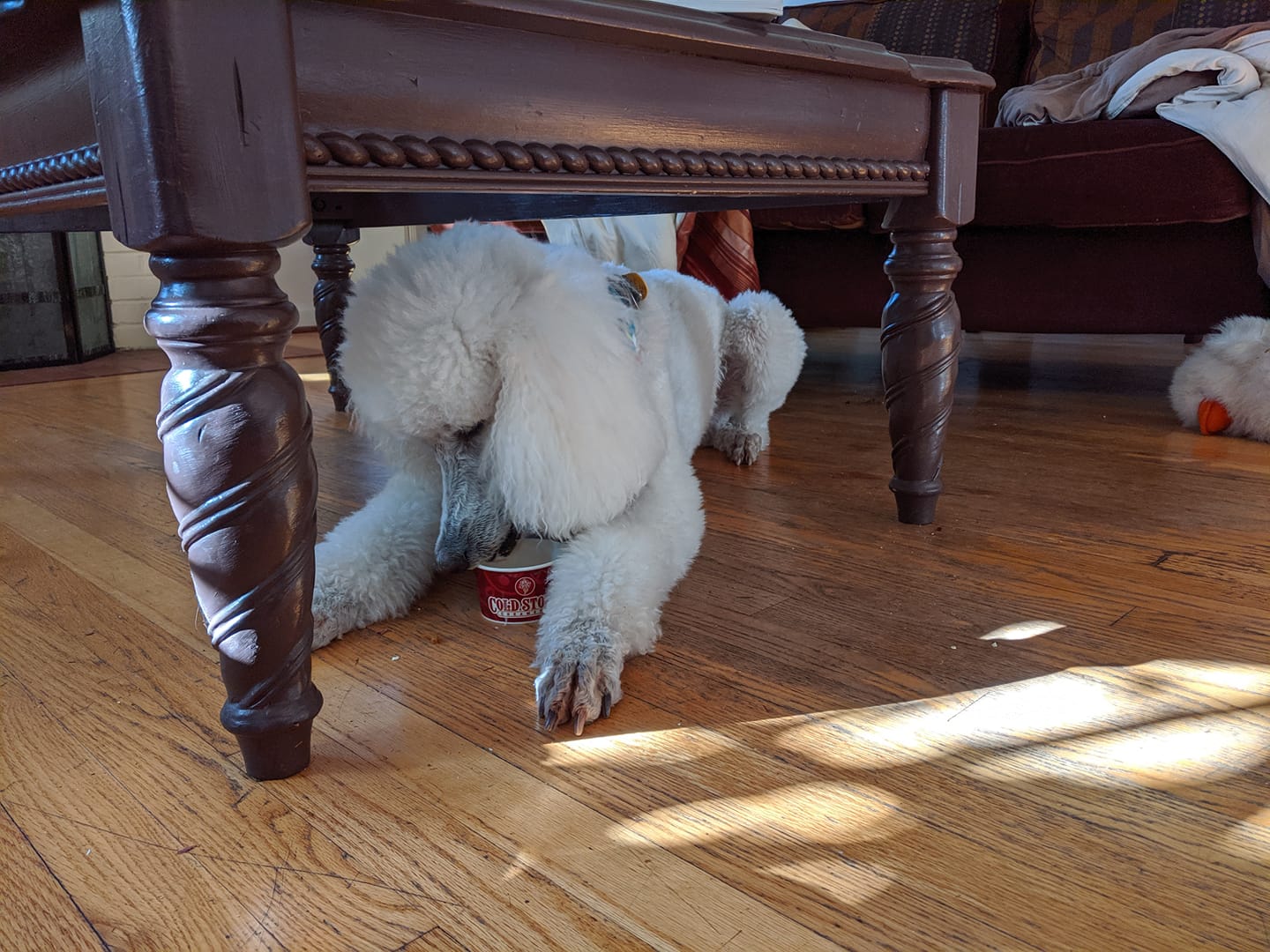
We still wrestled with the under-a-table skill for over a year despite daily practice. She clearly understood the command and knew what was wanted of her, but just really didn't want to and did it so grudgingly... until the day I discovered that if I put a towel down for her, she no longer had any objections. I guess she felt it was dirty under tables??? I do not know her reasoning but I am pretty open to making an accommodation for her on this point and always keeping her purple towel in my tote bag so she can stay comfy and clean while working.
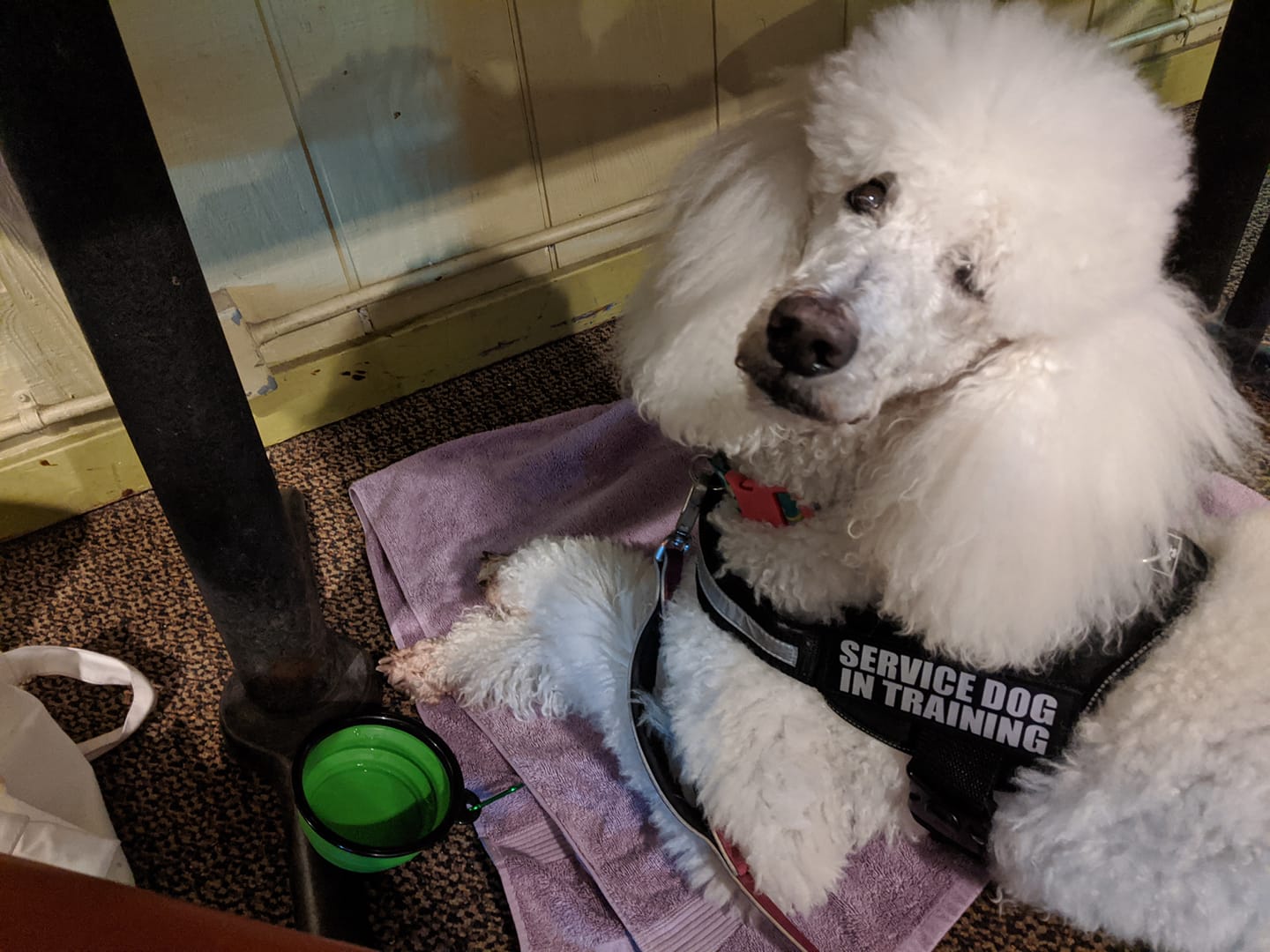
I'm pretty sure she's technically supposed to do it with or without the towel, but it seems like an okay request for her to make of me to me. ¯\_(ツ)_/¯

We still wrestled with the under-a-table skill for over a year despite daily practice. She clearly understood the command and knew what was wanted of her, but just really didn't want to and did it so grudgingly... until the day I discovered that if I put a towel down for her, she no longer had any objections. I guess she felt it was dirty under tables??? I do not know her reasoning but I am pretty open to making an accommodation for her on this point and always keeping her purple towel in my tote bag so she can stay comfy and clean while working.

I'm pretty sure she's technically supposed to do it with or without the towel, but it seems like an okay request for her to make of me to me. ¯\_(ツ)_/¯
Kim wrote:

Oh my god this picture is amazing!!
Claine wrote:
Kim wrote:

Oh my god this picture is amazing!!
I know right? On this particular day this photo was taken, she did this for 45 minutes before she was given the release command. I'm so proud of my hard worker!
I don't know if I could sit for 45 minutes with a plate of cheese under my nose 
What a good girl! That's so incredible, and you're both amazing!
Does she get cuddling like normal dogs, or more sedate petting? ^^
Does she get cuddling like normal dogs, or more sedate petting? ^^
I think your question is getting at whether or not she's still doglike or if all the training and responsibilities has made her more vulcan like? The answer to that question is: When she's not on duty as either a therapy dog or a service dog, she cuts loose like most any other dog you know. Some of my new neighbors know her not as a service dog at all, just as the goofy animal who plays ball outside their windows every day. She has childhood dog friends she likes to wrestle with. She begs for treats. She leans into you so hard you think you'll fall over wanting a good neck rub. Just today she led me on a ridiculous goose chase around the house with a stolen hot dog.
Most of the service dogs we know love to work hard, but they also play hard in their off time. They know very clearly the difference between work time and relaxing time in a way normal dogs do not.
But to answer the specific question: She has NEVER been a very cuddly dog, even as a puppy she clearly felt hugs were a massive invasion of personal space. She will pile up with me in bed at night, but rarely other situations and not with other people.
As she got older and started getting into her therapy profession, she surprised me by initiating hugs and cuddles with children in distress. Weirdly, this offer appears to evaporate the moment the therapy session is over; she only wants those sedate pets from her clients outside of the therapy environment.
Most of the service dogs we know love to work hard, but they also play hard in their off time. They know very clearly the difference between work time and relaxing time in a way normal dogs do not.
But to answer the specific question: She has NEVER been a very cuddly dog, even as a puppy she clearly felt hugs were a massive invasion of personal space. She will pile up with me in bed at night, but rarely other situations and not with other people.
As she got older and started getting into her therapy profession, she surprised me by initiating hugs and cuddles with children in distress. Weirdly, this offer appears to evaporate the moment the therapy session is over; she only wants those sedate pets from her clients outside of the therapy environment.
Oooh, Venice is adorable! Thank you so much for sharing all of this and so much information already.
With Venice being a service dog, does she have to go through more grooming to look presentable and meet the cleanliness standards compared to when she was simply your companion?
With Venice being a service dog, does she have to go through more grooming to look presentable and meet the cleanliness standards compared to when she was simply your companion?
Ooh, good question! YES, definitely, she has to endure way more baths.
Interestingly the therapy dog cleanliness standards are even higher than the service dog standards, so I don't know she noticed a change between the two careers, but she for sure noticed the difference between being a family dog and being a dog with a profession.
Even though she clearly misses working a great deal, I do think this pandemic year has been a fun break from getting bathed sometimes multiple times a week.
Interestingly the therapy dog cleanliness standards are even higher than the service dog standards, so I don't know she noticed a change between the two careers, but she for sure noticed the difference between being a family dog and being a dog with a profession.
Even though she clearly misses working a great deal, I do think this pandemic year has been a fun break from getting bathed sometimes multiple times a week.
What's the absolute coolest trick/task Venice has learned in your opinion? 
HAHA thank you for the opportunity to further brag on my beautiful smart baby.  I think objectively, her coolest trick is talking.
I think objectively, her coolest trick is talking.
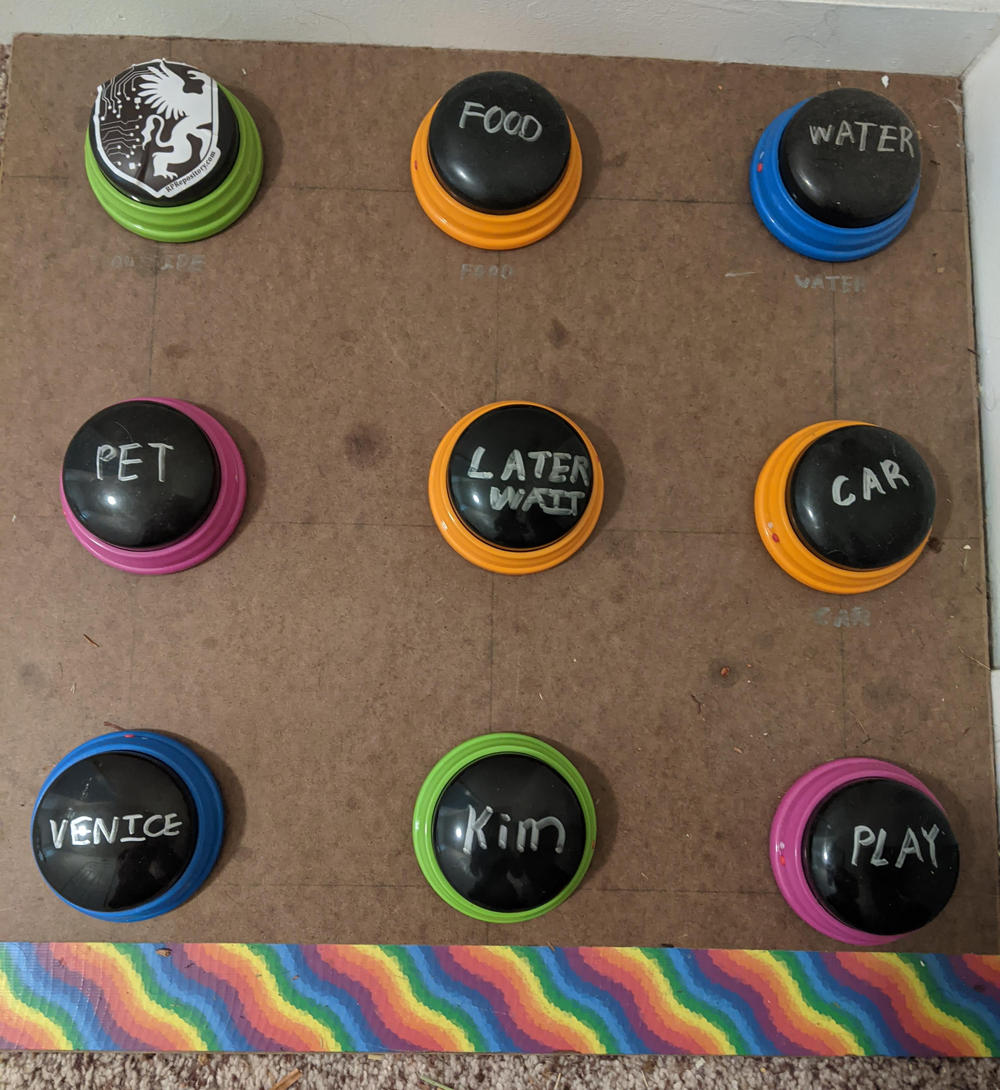
The button with the RPR sticker on it says "Outside." The sticker was just there to give her another visual queue as to how the talk board is oriented in a given moment so she can position herself and hit the button she actually means, even if I move the board or take it with us to the park.
She mostly still only uses single words at a time, but occasionally she does small sentences like "Venice car food" (translation: take me to a drive through; buy me a hamburger)
Subjectively, probably my favorite trick or task is whatever we just worked on learning together most recently.

The button with the RPR sticker on it says "Outside." The sticker was just there to give her another visual queue as to how the talk board is oriented in a given moment so she can position herself and hit the button she actually means, even if I move the board or take it with us to the park.
She mostly still only uses single words at a time, but occasionally she does small sentences like "Venice car food" (translation: take me to a drive through; buy me a hamburger)
Subjectively, probably my favorite trick or task is whatever we just worked on learning together most recently.
What's the etiquette around service dogs in public spaces where someone is allergic to dogs? With Venice being a poodle, this may be something you have don't have much personal experience with, but it's always something I wonder about. Like, can you be denied entry to an establishment if someone there is allergic?
You're right that this is not something I run into with Venice, so I don't have a lot of personal experience with it. However, my understanding is that the law in the US states that businesses and other public spaces must provide "reasonable accomodations" for a person with a disability, but also that they do not have to do so if it would cause "undue hardship" for the business. Service dogs are generally included as a reasonable accommodation in almost every circumstance. However, what is reasonable and what is an undue burden is highly context dependent.
If an employee gets mildly itchy for a little while when a service dog comes through, but the person with the service dog needs that dog to navigate or be safe, generally service dog trumps mild annoyance. The business might have to make a "reasonable accomodation" for that employee's allergy in some way if the allergy is bad, for example letting them go on break if the disabled person is just running in and out to buy a bag of chips, moving the employee to a different part of the store briefly, whatever.
But then if you're in a situation where it's a teeny tiny little storefront that only has room for one worker at a time and that worker might go into anaphylaxis around a service dog, the reasonable accommodation might actually be that both disabled person and their service dog remain outside of the business and the employee brings what they need to the door instead of making them come in and picking it out themselves. That way, everyone gets what they need and no one is placed at risk.
Just like every disability presents differently, there's rarely one size fits all accommodation for every group of people and every situation. Creativity is encouraged to handle the ADA balancing act in a helpful, humane and practical way.
If an employee gets mildly itchy for a little while when a service dog comes through, but the person with the service dog needs that dog to navigate or be safe, generally service dog trumps mild annoyance. The business might have to make a "reasonable accomodation" for that employee's allergy in some way if the allergy is bad, for example letting them go on break if the disabled person is just running in and out to buy a bag of chips, moving the employee to a different part of the store briefly, whatever.
But then if you're in a situation where it's a teeny tiny little storefront that only has room for one worker at a time and that worker might go into anaphylaxis around a service dog, the reasonable accommodation might actually be that both disabled person and their service dog remain outside of the business and the employee brings what they need to the door instead of making them come in and picking it out themselves. That way, everyone gets what they need and no one is placed at risk.
Just like every disability presents differently, there's rarely one size fits all accommodation for every group of people and every situation. Creativity is encouraged to handle the ADA balancing act in a helpful, humane and practical way.
The other bit I want to mention is that since service dogs A) keep to themselves and don't attempt to interact with anyone but their handler and B) are often groomed to within an inch of their life, they don't spread near as much dander as your average family dog even if they aren't a hypoallergenic breed. Dander is the thing that causes people's allergic reactions to dogs. So they're often less of a hassle for allergy sufferers than some random pooch.
Which is not to say it can't be or never is an issue!
Which is not to say it can't be or never is an issue!
Going off on a tiny bit of a tangent: I've often wondered if my dog might make a good therapy dog because he loves everyone (and particularly loves kids), he's not scared of wheelchairs, he's passed his CGC test, and he's small (so about as non-intimidating as a dog can get). However, he's a licker - two or three hand licks usually just to say hello. I've heard that's a huge no-no for a therapy dog. Do you know if that's true across all therapy organizations?
